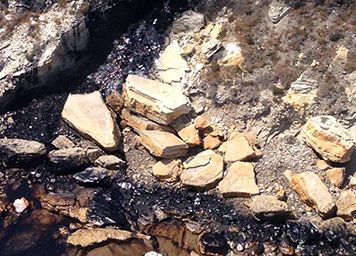NOAA Joins Response to Pipeline Oil Spill at Refugio State Beach Near Santa Barbara, California
POSTED MAY 20, 2015 | UPDATED MAY 21, 2015 -- On May 19, 2015, NOAA was notified of a 24-inch pipeline rupture that occurred earlier in the day near Refugio State Beach in Santa Barbara County, California.
A reported 500 barrels (21,000 gallons) of crude oil flowed from the shore side of Highway 101 into the Pacific Ocean. The source has since been secured.
As of May 21, Office of Response and Restoration oceanographers estimate that forecasted winds and currents in the affected area of the oil spill will move the slick eastward parallel to the shore Thursday night and Friday. The oil consists of patches and streaks of various sizes and thicknesses, broken up and spread over approximately 20 miles of coast and up to 5 miles offshore. The percent of oil floating on the surface in the slicks is low, estimated to be less than 10 percent in the affected area.
Cleanup measures include skimmers, vacuum trucks, absorbent pads, and absorbent boom. Shoreline Cleanup Assessment Technique (SCAT) teams are documenting the level of oil and impacts to the shoreline. 7,777 gallons of an oil and water mixture have been collected from the ocean. Several oiled birds, including pelicans, and an oiled California sea lion were found stranded and are being taken care of by official wildlife rehabilitation teams.
According to the U.S. Coast Guard, a commercial oil spill response company is conducting cleanup operations. Boats are collecting oil offshore. California Department of Fish and Wildlife has ordered beach closures. The U.S. Coast Guard has organized the Incident Management Team and is conducting overflights. The U.S. Environmental Protection Agency is also responding and is focusing on the site of the pipeline break and inland cleanup.
The Office of Response and Restoration's Jordan Stout is on-scene as the NOAA Scientific Support Coordinator as well as an OR&R overflight observation specialist. OR&R has been providing information on fate and effects of the crude oil and potential environmental impacts both in the water and on the shore.
In this preassessment phase scientists are researching what resources may have been exposed to the oil and whether to proceed with a Natural Resource Damage Assessment. Additional scientists will be deployed to the area in the coming days. Also from NOAA, the National Weather Service, the National Marine Fisheries Service, the Restoration Center, and the Office of National Marine Sanctuaries are providing support.
In 1969, a major oil spill occurred in the Santa Barbara area as a result of a well blowout. One of the largest environmental disasters in U.S. waters at that time, the legacy of that incident includes the creation of the National Environmental Policy Act, U.S. Environmental Protection Agency, and National Marine Sanctuaries system (which soon encompassed California’s nearby Channel Islands, which were affected by the 1969 Santa Barbara spill).
For further information, see the Joint Information Center website: Refugio Response Information.

 An official website of the United States government.
An official website of the United States government. 

